
Test your knowledge of ICD-10 coding and documentation requirements for five diagnoses you're likely to encounter in family medicine.
Fam Pract Manag. 2015;22(5):15-21
Author disclosure: no relevant financial affiliations disclosed.
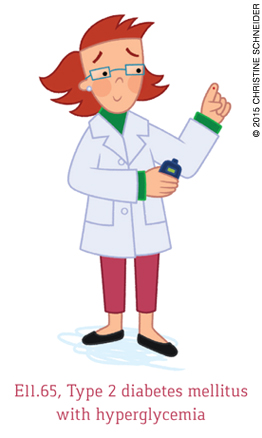
The time has come. Are you ready for the Oct. 1 transition to ICD-10 diagnosis coding? If you are not sure, you are not alone. Many elements of this transition have depended on your software vendors, clearinghouses, payers, and staff, but there is one thing you can control: your documentation of the information necessary to support the diagnosis codes you choose to bill. Your documentation probably does not need a major overhaul, but you will need to be more specific and detailed in certain areas. In this article, we will look at the documentation elements required to support ICD-10 code selection, focusing on five common conditions in family medicine. Quizzes will test your knowledge throughout the article.
First, why should you care?
The increased specificity required in your documentation and coding under ICD-10 may seem unnecessarily burdensome. However, diagnosis coding has a wider impact than you might immediately recognize.
Question: In which of the following ways does diagnosis coding affect physician practices and patient care?
Diagnosis codes support the medical necessity of services provided.
Diagnosis codes support claims payment.
Diagnosis data is increasingly used to evaluate cost and quality of care.
Diagnosis data is used to influence public health policy.
All of the above.
Answer: The diagnosis codes reported on physician claims must be supported not only to facilitate payment but also because they become the data upon which decisions beyond claims payment are made. The correct answer to the above question, then, is E, all of the above.
Documentation that supports specific diagnosis coding also may alleviate burdensome medical record requests from third parties. Take for instance the following statement a physician forwarded to me from a claims administrator regarding medical record requests to support risk adjustment: “ICD-9-CM (or its successor ICD-10-CM) diagnosis codes determine a patient's risk score. The more diagnosis detail submitted with claims and encounters, the less likelihood that [insurer name redacted] will need to request and audit medical records.” In other words, if your documentation supports the level of service coded and the selected diagnosis codes specifically identify the nature of your patient's condition, you are less likely to receive a request for your medical record. If a request is made, your documentation will support both the service provided and why it was provided.
DOCUMENTATION ELEMENTS FOR COMMON DIAGNOSES
This article contains seven tables outlining the documentation elements for common diagnoses. All seven tables are available for download as a single resource.
What to report
Before we review common diagnoses, it is important to know when codes should and should not be reported for a condition.
Question: According to the official guidelines for ICD-10, which of the following conditions should be reported?
All conditions listed in the problem list.
Only conditions with confirmed and differential diagnoses.
All conditions that require or affect patient care or treatment at the time of the encounter.
Only the condition related to the chief complaint.
Conditions that are probable.
Answer: The ICD-10 guidelines (like ICD-9) specify that physicians should not report the following:
Conditions documented as probable, likely, or to be ruled-out (rules differ for facilities),
Codes for symptoms that are integral to an established diagnosis,
Conditions that are no longer present,
Conditions that did not affect management or treatment at the current encounter.
Therefore, the answer to the question is C. All conditions that require or affect patient care or treatment at the time of the encounter should be reported. Physicians should list first the condition that is chiefly responsible for the services provided and code what is known at the time of the encounter.
This instruction to code what is known at the time of the encounter is important. Based on this guideline, physicians should report unspecified codes such as J12.9, unspecified viral pneumonia, when the information known at the time of the encounter does not support a more specific diagnosis. The guidelines state, “It would be inappropriate to select a specific code that is not supported by the medical record documentation or conduct medically unnecessary diagnostic testing in order to determine a more specific code.”
Other important documentation guidelines include the following:
List first a disease and then associated manifestations,
Link sequelae (late or residual conditions) to the history of an injury or past medical condition,
Report personal or family history codes when the history affects care or influences treatment.
Five common diagnoses
With so many diagnoses in primary care, it makes sense to focus your ICD-10 education efforts on those that are common in your specialty. The National Center for Health Statistics provides this data.1
Question: Which condition is the top reason for office or other outpatient visits to family physicians?
Diabetes.
Hypertension.
Otitis media.
Asthma.
Well-child examinations.
Answer: All of the above conditions are near the top of the list for family medicine, but for the number one diagnosis, you'll have to read on. Let's take a look at five commonly reported diagnoses and their documentation requirements under ICD-10.
Number five: asthma
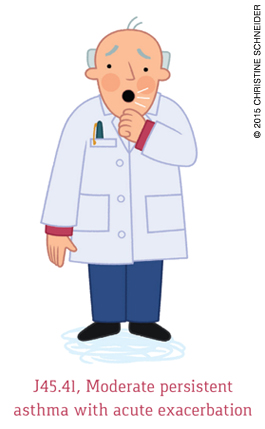
Asthma classification in ICD-10 mirrors the guidelines from the National Asthma Education and Prevention Program, which differs from ICD-9.2
Question: Which of the following is not an option for the classification of asthma in ICD-10?
Intrinsic.
Mild intermittent.
Mild persistent.
Moderate persistent.
Severe persistent.
Answer: All of the above classifications are options in ICD-10 except A, intrinsic. That was the old terminology used in ICD-9.
In addition to documenting the asthma classification, physicians should document the status of the condition at each encounter. “Table one: Documentation elements for asthma” includes the codes for each asthma classification by status.
| Asthma classification | Status | Code |
|---|---|---|
| Mild intermittent | Uncomplicated | J45.20 |
| With exacerbation | J45.21 | |
| Status asthmaticus | J45.22 | |
| Mild persistent | Uncomplicated | J45.30 |
| With exacerbation | J45.31 | |
| Status asthmaticus | J45.32 | |
| Moderate persistent | Uncomplicated | J45.40 |
| With exacerbation | J45.41 | |
| Status asthmaticus | J45.42 | |
| Severe persistent | Uncomplicated | J45.50 |
| With exacerbation | J45.51 | |
| Status asthmaticus | J45.52 |
Note: Personal risk factor codes, such as Z91.14, “Patient's other noncompliance with medication regimen,” may be added to indicate poor compliance and explain any complications.
If you were to document asthma without specifying the classification or status, that would be reported with code J45.909, unspecified and uncomplicated asthma. However, consider the implications of reporting J45.909 for a patient who is not compliant with control medications, is seen for an acute exacerbation, and requires a revised care plan. This code not only fails to identify the nature of the patient presentation but also fails to convey the assessment of the asthma status and the complicating factor of noncompliance. Documenting a bit more detail – moderate persistent asthma with exacerbation, J45.41 – better conveys the nature of the encounter. Code Z91.14 could be added to specify the patient's poor compliance with control medication and explain the patient management complications.
Number four: otitis media
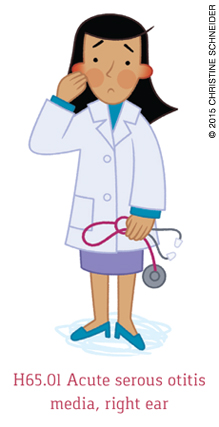
Both ICD-9 and ICD-10 provide codes to specifically identify otitis media as acute or chronic and as serous, allergic, or suppurative. Despite the availability of more specific codes, ICD-9 code 382.9 (unspecified otitis media) was frequently reported. Use of an unspecified code is appropriate when no further information is known at the time of the encounter; however, more specific reporting is appropriate when further information is known, and it typically better supports the level of service rendered.
Question: Specific reporting of otitis media includes which of the following documentation elements?
Type (e.g., serous).
Laterality (e.g., left).
Occurrence (e.g., chronic).
Tympanic membrane status (e.g., ruptured).
All of the above.
Answer: Each of the above documentation elements is important to fully identify the nature of the otitis media – answer E. An assessment of bilateral acute otitis media without indication of type (serous, suppurative, or in a disease classified elsewhere) would support code H66.93 (otitis media, unspecified, bilateral). But better documentation, such as acute recurrent bilateral suppurative otitis media without spontaneous rupture of the ear drum (H66.006), may help to identify the need for higher levels of medical decision-making or additional services. (See “Table two: Documentation elements for otitis media.”)
| Otitis media type | Code family | Occurrence | Laterality | Tympanic membrane status |
|---|---|---|---|---|
| Serous/nonsuppurative | H65.-- | Acute/subacute Acute recurrent Chronic | Right Left Bilateral | Ruptured Not ruptured |
| Suppurative/purulent | H66.-- | |||
| In a disease classified elsewhere (influenza, measles, viral disease), follow index instruction (combination code or H67) | H67.-- or combination code |
Number three: diabetes
Key documentation elements for diabetes are the type of diabetes, manifestations of the disease, and use of insulin (not necessary for type 1 diabetes). “Table three: Documentation elements for diabetes” illustrates the requirements.
| Diabetes type | Code family | Manifestation | Insulin use |
|---|---|---|---|
| Type 1 | E10.-- | Consider whether the condition is controlled; uncontrolled is a manifestation (hyperglycemia) Make a connection (e.g., diabetic ulcer vs. diabetes, ulcer) Describe the manifestation (e.g., site and severity of ulcer) | n/a |
| Type 2* | E11.-- | Z79.4 Long-term (current) insulin use | |
| Due to underlying condition | E08.-- | ||
| Drug or chemical induced | E09.-- |
*Type 2 is the default if type is not documented.
Question: Which of the following documentation elements would be required to accurately code an encounter with a patient who has diabetes, loss of protective sensation, a foot ulcer, and an elevated A1C result?
Type of diabetes.
Location of the ulcer.
Related conditions (manifestations).
Condition status/characteristics (e.g., uncontrolled).
All of the above.
Answer: If you chose E, all of the above, you are correct. Because this patient has manifestations, additional codes should be reported to describe the documented manifestations. Conditions such as type-2 diabetic neuropathy may be captured in a single combination code (e.g., E11.40 for diabetes type 2 with neuropathy). However, even combination codes cannot adequately describe some manifestations. A diabetic foot ulcer may be separately reported based on three documentation elements: site, laterality, and severity. (See “Table four: Documentation elements for foot ulcer.”) Codes describing nonpressure ulcers (categories L97.1-L97.9 and L98.41-L98.49) may be reported in addition to codes describing type 2 diabetes with foot or other skin ulcer (categories E11.621-E11.622).
| Foot ulcer site | Code family | Laterality | Severity |
|---|---|---|---|
| Heel and midfoot | L97.4-- | Right Left | Limited to breakdown of skin Fat layer exposed Necrosis of muscle Necrosis of bone |
| Other part of foot including toe | L97.5-- |
(For more information on documenting diabetes in ICD-10, see “Getting Ready for ICD-10: How It Will Affect Your Documentation,” FPM, November/December 2013.)
The following codes would be reported to describe care of a patient with poorly controlled diabetes, loss of protective sensation, and diabetic ulcer of the left great toe with the fat layer exposed:
E11.65, diabetes type 2 with hyperglycemia,
E11.40, diabetes type 2 with neuropathy,
E11.621, diabetic foot ulcer,
L97.502, ulcer left foot, toe, fat layer exposed.
Note that codes for type 2 diabetes are reported even though the documentation did not specify the type of diabetes. This is because the guidelines instruct that type 2 is the default when documentation does not specify the type. Also, the ICD-10 index includes subterms for inadequately controlled and poorly controlled diabetes that direct physicians to report diabetes by type with hyperglycemia.
Number two: well-child examinations
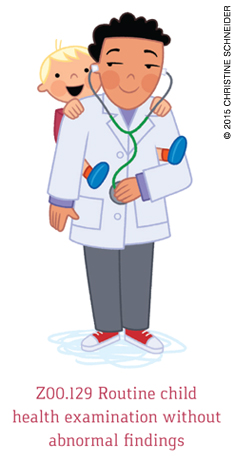
The second-most common diagnosis is the well-child visit. Documentation for this encounter requires two elements. The first is the age of the child.
Question: What is the second element you would need to document for a well-child visit for ICD-10?
Whether the examination resulted in abnormal findings.
Whether the patient is new.
Established conditions from the problem list.
Suspected conditions.
Symptoms related to an established diagnosis.
Answer: Aside from the age of the child, the other element you would need to document for ICD-10 is whether the examination resulted in abnormal findings – answer A. New in ICD-10 are separate codes for routine child health examinations with abnormal findings (Z00.121) or without abnormal findings (Z00.129). Even if an abnormal finding does not merit a separately identifiable evaluation and management service, if it requires future surveillance it should be reported as an additional diagnosis. Report Z00.121 as the first code and then add the code for the finding.
Similarly, routine adult health and gynecological examinations are reported based on the presence or absence of abnormal findings; see codes Z00.00-Z00.01 and Z01.411-Z01.419.
As with ICD-9, ICD-10 includes separate codes for reporting examinations of newborns less than 8 days old and newborns 8 days to 28 days old. These codes do not identify the presence or absence of abnormal findings:
Z00.110 Health examination for newborn under 8 days old,
Z00.111 Health examination for newborn 8 to 28 days old.
| Age of child | Exam findings | Code |
|---|---|---|
| Newborn under 8 days old | n/a | Z00.110 |
| Newborn 8 to 28 days old | Z00.111 | |
| Child | Abnormal Without abnormal | Z00.121 Z00.129 |
And the number one diagnosis is…
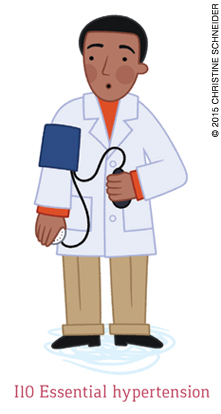
Hypertension is the condition most often reported as the reason for an ambulatory care encounter in family medicine.
Question: Which of the following are options for the classification of hypertension in ICD-10?
Benign.
Malignant.
Unspecified.
Uncomplicated.
None of the above.
Answer: Under ICD-9, physicians were challenged to classify hypertension as benign, malignant, or unspecified. This is simplified in ICD-10 with a single code, I10, for reporting hypertension, whether described as benign, malignant, or simply essential hypertension. The answer to the above question, then, is E, none of the above. However, coding for hypertensive conditions such as hypertensive heart or kidney disease can be more specific. Key documentation guidelines for these conditions include the following:
Categories I11, I12, and I13 include combination codes that describe hypertensive heart disease with or without heart failure, hypertensive chronic kidney disease, and hypertensive heart and chronic kidney disease. (See “Table six: Documentation elements for hypertensive diseases.”)
The causal relationship between hypertension and heart disease must be documented (e.g., due to hypertension or hypertensive). If documentation does not indicate hypertension as a cause of the heart disease, separate codes for hypertension and the specified heart condition must be reported.
An additional code from category I50 must be assigned to identify the type of heart failure in patients with hypertensive heart disease with heart failure.
Unlike hypertension with heart disease, a cause-and-effect relationship is presumed for hypertension with chronic kidney disease. Report hypertensive chronic kidney disease when both diseases are present.
Codes in category N18 are reported in addition to the code for hypertensive chronic kidney disease to indicate the stage of the disease.
| Hypertensive disease type | Code family | Complication |
|---|---|---|
| Essential hypertension | I10 | n/a |
| Hypertensive heart disease* | I11.- | With or without heart failure** |
| Hypertensive chronic kidney disease | I12.- | With stage 5 chronic kidney disease or end stage renal disease With stage 1 through stage 4 chronic kidney disease, or unspecified chronic kidney disease |
| Hypertensive heart and chronic kidney disease* | I13.-- | With or without heart failure** With stage 5 chronic kidney disease or end stage renal disease With stage 1 through stage 4 chronic kidney disease, or unspecified chronic kidney disease |
To further illustrate these documentation elements, consider a patient for whom you have made the following assessment: hypertension and left ventricular hypertrophy. Codes assigned for this encounter would be I10 for hypertension and I51.7 for cardiomegaly. However, if your assessment was hypertension and hypertensive left ventricular hypertrophy, code I11.9 would be assigned for hypertensive heart disease without heart failure.
(For more information on documenting hypertension in ICD-10, see “How to Document and Code for Hypertensive Diseases in ICD-10,” FPM, March/April 2014.)
Beyond the top five
Several common documentation elements support better coding for conditions beyond just the top five diagnoses. These elements – type, location, occurrence, characteristics, and related conditions – are listed with examples of each in “Table seven: Common documentation elements.” As you review the table, consider how each element might be applied to diagnoses that you frequently manage.
| Type |
|
| Location |
|
| Occurrence |
|
| Characteristics |
|
| Related conditions |
|
Don't panic
It may take a while to gain proficiency and gather resources to help you document and select ICD-10 codes that appropriately report the conditions you are managing. Acknowledging this, the Centers for Medicare & Medicaid Services and the American Medical Association recently announced a one-year grace period during which Medicare claims will not be denied solely because the diagnosis code is not specific enough – as long as it is from the appropriate family of ICD-10 codes (the three-character category) and is a valid code.
As you become more familiar with the codes, work toward greater specificity and accuracy, and look for ways to improve your coding and documentation processes and systems. For example, you might ask your electronic health record vendor about creating a “favorites” list of ICD-10 codes. Just remember that this time of transition will pass, but adopting better documentation and coding habits that capture the true nature of the conditions you manage and the quality of care you provide will be to your advantage as heath care transitions from fee-for-service to value-based payment.
ARTICLES IN FPM'S ICD-10 SERIES
You can access the following articles in FPM's ICD-10 topic collection:
"ICD-10: Major Differences for Five Common Diagnoses," FPM, September/October 2015.
"ICD-10 Sprains, Strains, and Automobile Accidents," FPM, May/June 2015.
"Digesting the ICD-10 GI Codes," FPM, January/February 2015.
"Coding Common Respiratory Problems in ICD-10," FPM, November/December 2014.
"ICD-10 Simplifies Preventive Care Coding, Sort Of," FPM, July/August 2014.
"ICD-10 Coding for the Undiagnosed Problem," FPM, May/June 2014.
"How to Document and Code for Hypertensive Diseases in ICD-10," FPM, March/April 2014.
"10 Steps to Preparing Your Office for ICD-10 – Now," FPM, January/February 2014.
"Getting Ready for ICD-10: How It Will Affect Your Documentation," FPM, November/December 2013.
"The Anatomy of an ICD-10 Code," FPM, July/August 2012.
"ICD-10: What You Need to Know Now," FPM, March/April 2012.
